Among the major global hotel chains, Marriott and Hilton are probably the two most compelling brands for Canadian travellers looking to maximize their gains through loyalty programs.
Both have impressive footprints around the world, and their respective loyalty programs allow you to earn points relatively easily without necessarily having to spend a lot of money out-of-pocket, while also providing users with aspirational redemption sweet spots.
So how do they stack up against each other? Is Marriott Bonvoy’s reputation as the best hotel loyalty program for Canadians justified, or are there areas in which Hilton Honors is in fact more advantageous?
The Value of a Point
Whenever we compare different loyalty programs, it’s useful to establish the relative value between a single point in each program.
In this case, we generally value Marriott Bonvoy points at 0.8 cents per point (CAD) and Hilton Honors points at 0.6 cents per point (CAD), so we’ll refer to these a priori valuations throughout the head-to-head comparison.
It may be tempting to conclude immediately from these valuations that Marriott Bonvoy is the more valuable program, but that’s not necessarily the case for every type of traveller, as we shall see.
Earning Points
The more avenues a loyalty program offers to accumulate respectable quantities of points, the easier it is for us to engage with it and derive benefits from the program.
Both Marriott Bonvoy and Hilton Honors offer a variety of ways to earn points, so let’s look at each one in turn.
Credit Card Welcome Bonuses
Marriott Bonvoy has two co-branded credit cards in Canada: the American Express Marriott Bonvoy Card and the American Express Marriott Bonvoy Business Card.
Over the years, welcome bonuses on these cards have ranged from 50,000 to 80,000 Bonvoy points, making them solid choices for Canadians looking to jumpstart their hotel points journey.
Dipping into the US credit card market opens up even more possibilities for Bonvoy loyalists. The Amex US Marriott Bonvoy Brilliant Card, Amex US Marriott Bonvoy Bevy Card, and the Amex US Marriott Bonvoy Business Card have reached up to 185,000 points at their peak, along with a host of additional perks like annual Free Night Awards and elite status boosts.
Furthermore, Chase has four co-branded Marriott Bonvoy cards, ranging from premium to no-fee: Bountiful, Boundless, Bold, and the Ritz-Carlton Card (which can only be obtained by upgrading from one of the other three). These cards also come with competitive welcome bonuses and benefits worth exploring for serious Bonvoy enthusiasts.
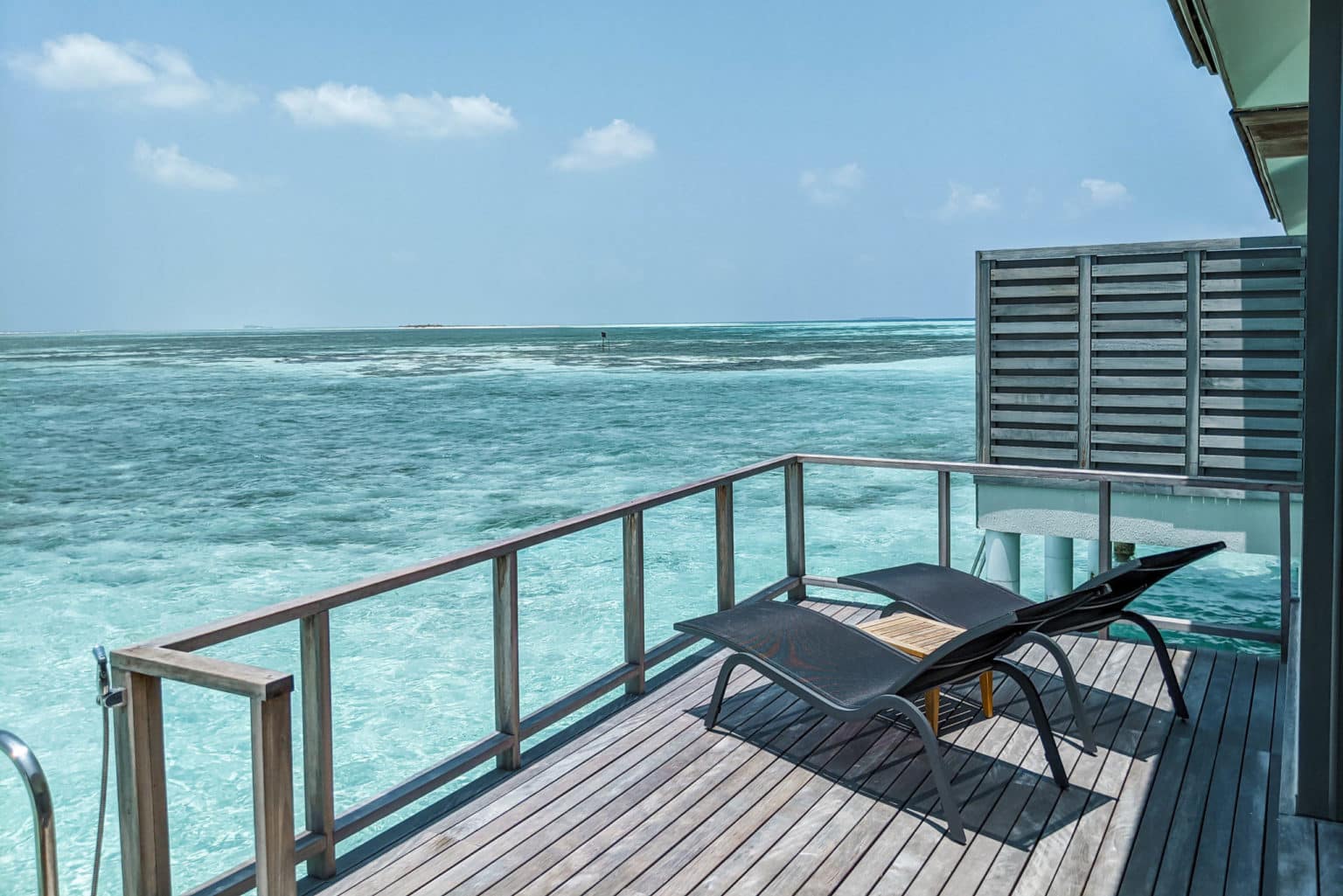
Meanwhile, Hilton Honors does not have a co-branded product in the Canadian market; instead, any available credit card offers can only be accessed through the US credit card market.
The good news is that Canadians can easily initiate an American Express Global Transfer to one of Hilton’s Amex US products: the Hilton Honors Card (100,000 points), the Hilton Honors Surpass Card (130,000 points), or the Hilton Honors Aspire Card (150,000 points).
Verdict: Marriott is the winner here, since they make it easier for Canadians to earn points through credit card welcome bonuses without having to dabble with US credit cards.
However, the generous bonuses and benefits like the instant Hilton Honors Diamond status or Annual Free Night Awards can be well worth the trouble of going through Amex Global Transfer.
Credit Card Spending
The most powerful points earning rate on a Bonvoy-branded credit card is probably the “5-3-2” structure on the Amex Business Bonvoy. You’ll earn 5 points per dollar spent at Marriott hotels, 3 points per dollar spent on gas, dining, and travel, and 2 points per dollar spent on everything else.
The US-issued Hilton cards offer a high rate of return when staying at Hilton hotels, although the base earning rate is a uniform 3x on general purchases outside of the United States. The only exception to this is the 7 points per dollar spent on select travel purchases with the Hilton Honors American Express Aspire Card.
When making purchases outside of bonus categories, I’d actually lean toward using one of the US-issued Hilton credit cards, assuming you have access to both programs.
Hilton points are generally harder to come by for Canadians, so it makes sense to prioritize earning them whenever possible.
Plus, the US Hilton co-branded cards have no foreign transaction fees, making them a convenient choice for spending abroad or when booking travel in foreign currency.
Verdict: While Marriott Bonvoy cards are easier to get in Canada, the US Hilton credit cards pull ahead for ongoing spending, especially given the scarcity of Hilton points for Canadians and the ease of using Hilton cards globally without incurring FX fees.
Transferring from Other Programs
Both Marriott Bonvoy and Hilton Honors are transfer partners from American Express Membership Rewards (MR), with transfer ratios of 1:1.2 and 1:1 respectively. There are occasional transfer bonus promotions to both programs, at which point the ratios would be temporarily increased in your favour.
There’s limited value in converting your Membership Rewards points to either hotel program, since they can be much more effectively redeemed for airline rewards. However, if you need to top up your balance in either program for an aspirational redemption, you can still get decent value out of the transfer.
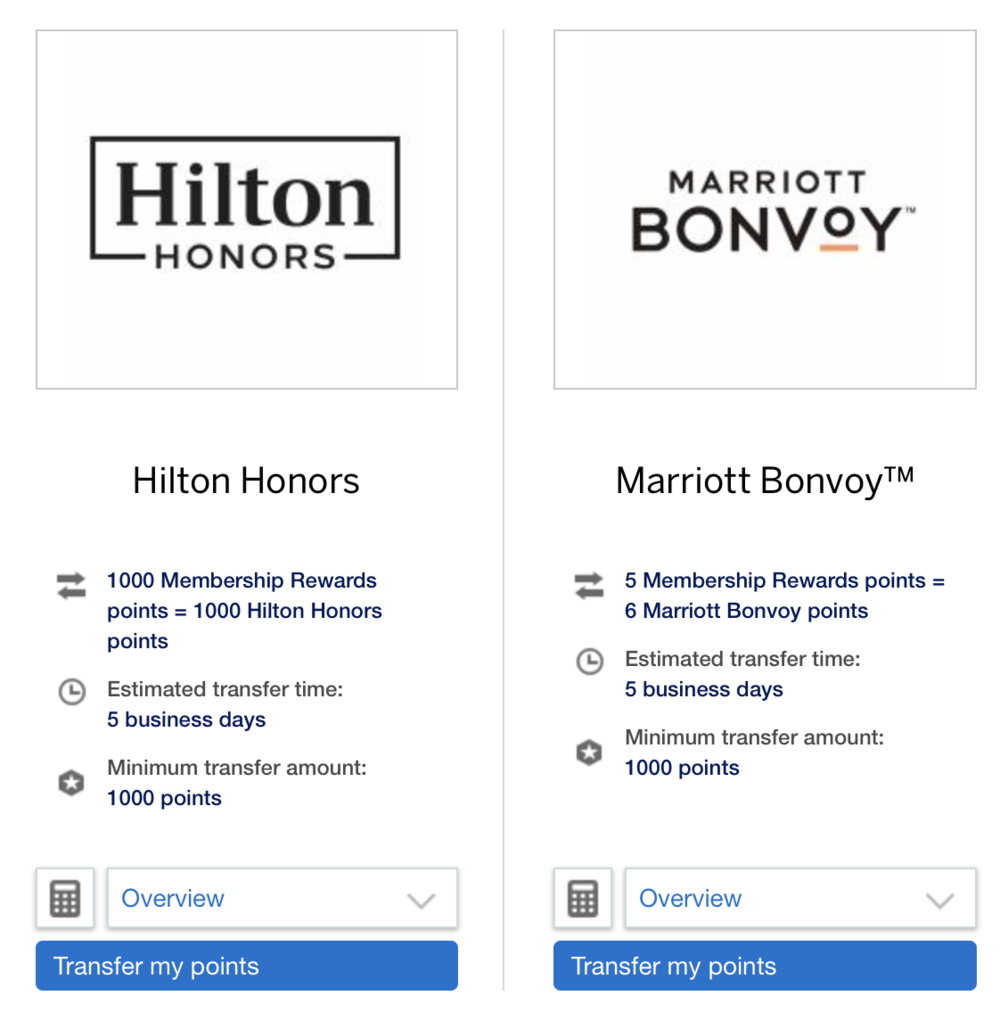

Verdict: Although both programs allow transfers from Amex MR points, Marriott Bonvoy is the more compelling option, thanks to a superior transfer ratio.
Hotel Stays
Ignoring elite bonuses (we’ll get to that later), both Marriott Bonvoy and Hilton Honors give users 10 points per US dollar spent at full-service properties and 5 points per US dollar spent at limited-service properties.
Both programs also routinely put on promotions for users to earn additional points from their stays, such as a window of opportunity to earn double points on every stay.
Verdict: Bonvoy and Honors both follow the same industry standard here, but Marriott Bonvoy comes out ahead if we compare the relative values of the two points currencies you’re earning.
Buying Points
Purchasing points outright is never the first-choice option for padding your balances, but it can always be useful if you need a handful of extra points in a pinch.
Marriott and Hilton both allow you to buy points, at usual rates of 1.25 US cents per point and 1 US cent per point, respectively. Neither of these options are particularly compelling, and should only be used if you desperately need to top-up your account for an upcoming redemption.
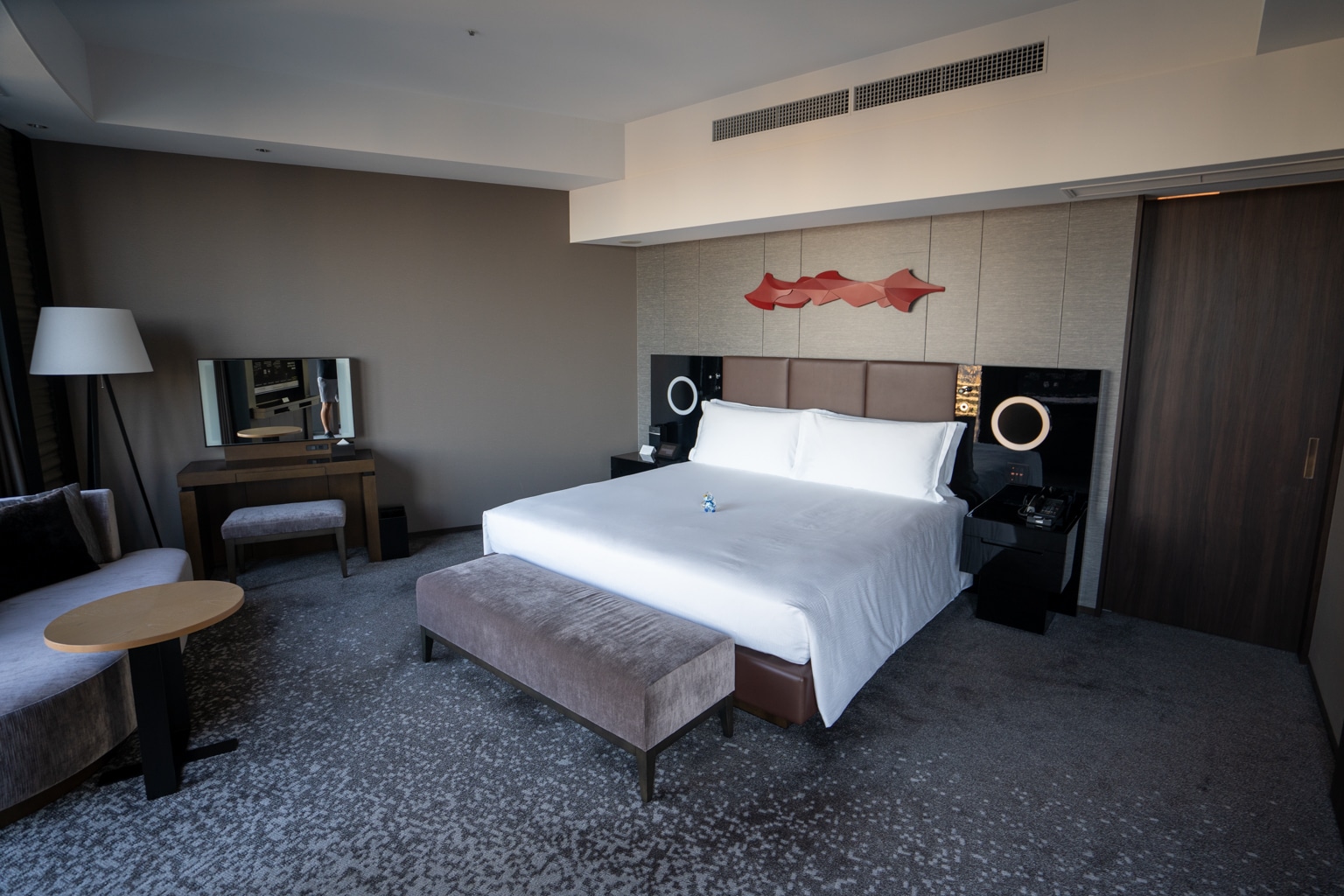

However, both programs often put on promotions allowing users to buy points at a discount.
In the recent past, Marriott Bonvoy’s most generous promotion so far has been a 60% bonus, reducing the purchase price to 0.78 US cents per point.
Meanwhile, Hilton often puts on generous 100% bonuses when buying points, which is equivalent to a 50% discount. This lowers the purchase price to 0.5 US cents per point, which is an offer I’d take up well before Marriott’s discounted offer, especially if I’m looking at booking some aspirational Hilton hotel stays.
Verdict: Hilton’s frequent 100% bonus events on points purchases make it the winner in this category. If you’re looking for opportunities to strategically buy points to get a discount on high-value hotel stays, you’d be much better served with Hilton than with Marriott.
Redemption Sweet Spots
It’s only meaningful to talk about points earning opportunities if we also consider what you can redeem those points for. On balance, how many free nights at a hotel can you unlock using the credit card signup bonuses (and other earning opportunities we covered above) from each program?
Again, this question can be broken down into several different considerations:
Low-End Hotels
Some travellers prefer to use their hotel points to cover as many free hotel nights as possible, with little regard for the luxury factor that might come with higher-tier hotels within a program.
Marriott Bonvoy has now fully transitioned to a dynamic pricing model, meaning there’s no fixed award chart and redemption rates can vary based on demand.
That said, some properties continue to hover at consistently low point prices, especially in regions like Southeast Asia.
For example, it’s still possible to find low-end hotels in Kuala Lumpur below 10,000 points per night, offering great value if you’re looking to stretch your Bonvoy balance.
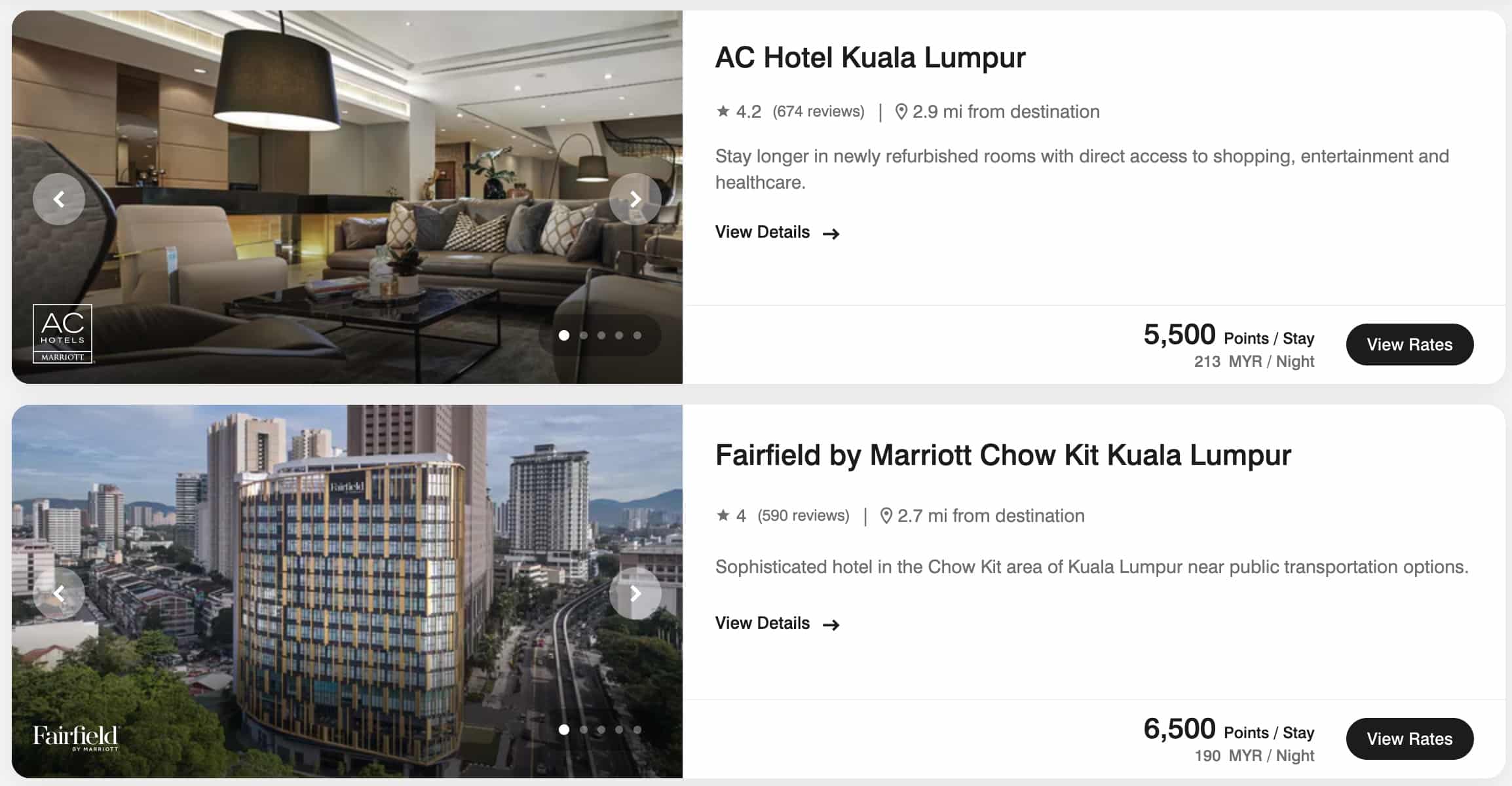

Mid-Range Hotels
If you’re after a touch more comfort without going full-on luxury, mid-range hotels can offer exceptional value, especially when cash prices are steep.
Take the JW Marriott Hotel Ankara, for example. Rooms can go for upwards of $370 (CAD) per night, yet we’ve seen redemption rates hover around 13,000 Bonvoy points—a solid deal by any measure.


These types of redemptions are perfect if you’re looking to maximize both comfort and value, and they’re not limited to just one region. With a bit of digging, similar sweet spots can be found in other parts of the world as well, where the cash-to-points ratio makes using Bonvoy points an easy choice.
On the other hand, let’s look at some ways to use the welcome bonus from the base-level Hilton Honors Card from Amex US, which offers up to 100,000 Hilton Honors points for no annual fee.
Instead of using a fixed reward chart, Hilton Honors also prices their hotels dynamically, meaning that the award cost varies based on many different factors. You’ll therefore have to look up your specific hotel to figure out its exact award cost, and we can only make rough judgments on how many free hotel nights you might get with a certain number of Hilton points.
While a select few Hilton properties around the world are priced as low as 7,000 points per night, most mid-range hotels in semi-popular destinations around the world are priced at 20,000–40,000 points per night.
At the lower end, you can find properties such as the Tru by Hilton Lang Son City Centre for only 7,000 points per night.
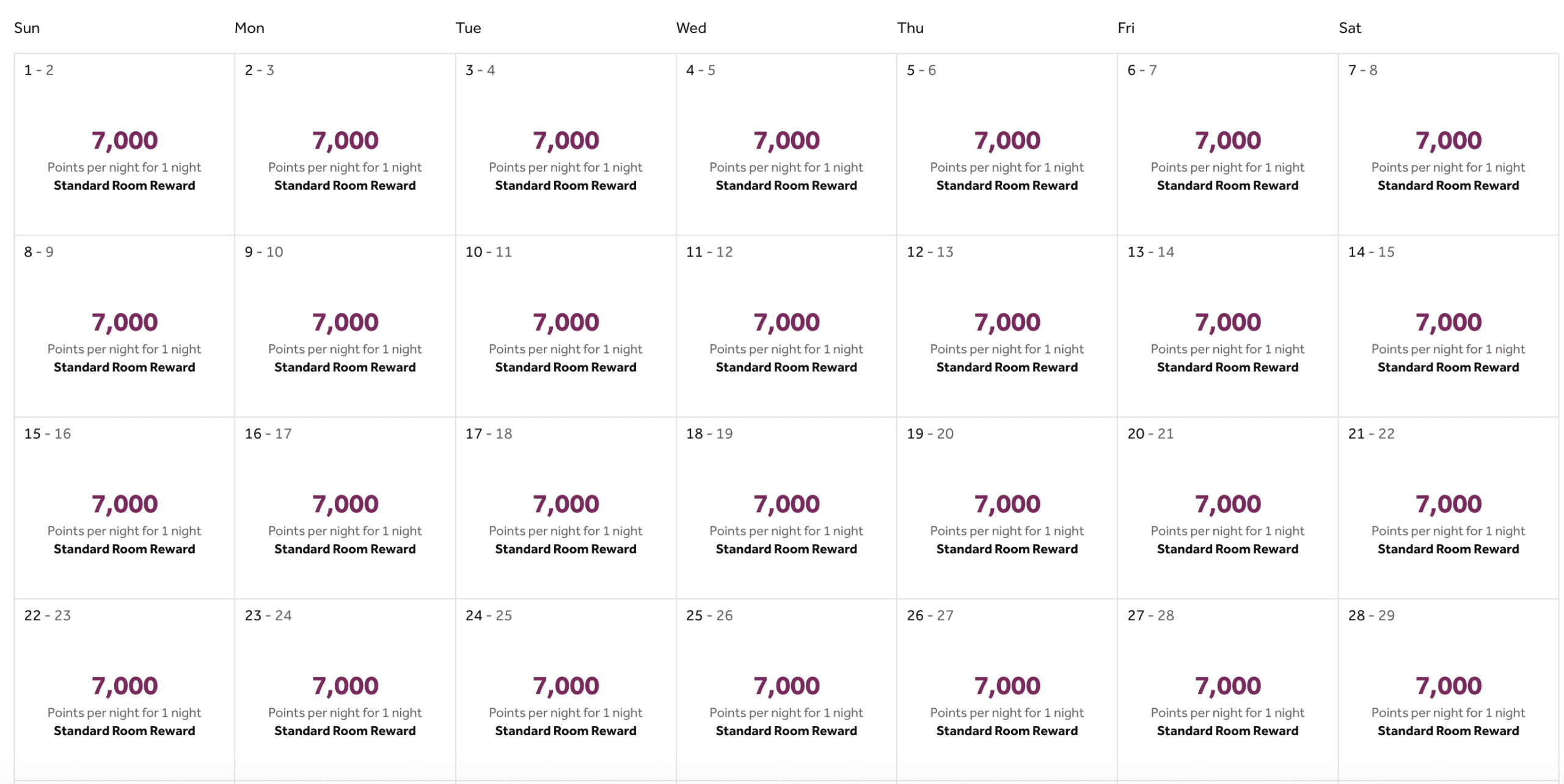

Moving up to a mid-range hotel, the Hilton Kuala Lumpur tends to price out at around 30,000 points per night.


Therefore, similar to Marriott Bonvoy, your welcome bonus will be good for around two to five nights at a non-luxury property (taking into account the Fifth Night Free benefit, which Hilton also offers). If you redeem points for hotels at the lowest cost in each program, you can get up to around 18 nights with a single welcome bonus.
Of course, this was only the base-level Hilton credit card and the base-level Bonvoy credit card; the higher-end cards from Amex US can certainly be used to cover even more hotel nights on your trip.
Verdict: On balance, I’d put Marriott and Hilton roughly on par in terms of redeeming free nights at low-end or mid-range hotels. It will be interesting to see how the two programs compare once Marriott Bonvoy joins Hilton with dynamically-priced hotel redemptions.
High-End Luxury Hotels
In contrast, other travellers prefer to redeem their points for special stays at aspirational hotels, and are happy to redeem a larger chunk of points for a luxury experience that would otherwise cost them an even larger chunk of cash.
On the higher end of the dynamic spectrum for Marriott Bonvoy, you can expect to pay around 100,000–140,000 points per night. While this may give you sticker shock at first, consider that the same hotels can cost upwards of $2,500 (CAD) per night, so parting ways with a large volume of points can still result in a great deal.
For example, the St. Regis Maldives Vommuli costs between 102,000–136,000 Bonvoy points per night, depending on the season and availability.


On the other hand, Hilton Honors’s top-tier properties are priced at around 80,000–100,000 Hilton Honors points per night at most (again, the pricing varies throughout the year).
Of course, there are exceptions to this, such as the stunning Waldorf Astoria Maldives Ithaafushi, which goes for 150,000 Hilton Honors points.


Verdict: On the luxury end of the spectrum, the relatively lower value of a single Hilton Honors point actually works in its favour.
Both programs cap their most aspirational properties at the region of 100,000–150,000 points, but since an equal amount of Hilton points would fetch less if redeemed elsewhere, it’s a better deal to drop an obscene sum of Hilton points than an equally obscene sum of Marriott points for a luxury stay.
Free Night Certificates
With Marriott Bonvoy, you can earn Free Night Awards through credit card benefits and the elite status program. With Hilton Honors, you can only earn Free Night Rewards through credit card benefits.
Marriott Bonvoy’s Free Night Awards come in various denominations. Depending on how you earn a Free Night Award, its potential value changes.
With the Marriott Bonvoy American Express Card, the Marriott Bonvoy Business American Express Card, the Amex US Marriott Bonvoy Card, the Amex US Marriott Bonvoy Business Card, and the Chase Marriott Bonvoy Boundless Card, you’ll get a Free Night Award worth 35,000 points upon your card’s anniversary date.


If you are a Titanium Elite member, you can select a Free Night Award that’s worth 40,000 points as an Annual Choice Benefit.
With the Amex US Marriott Bonvoy Bevy Card and the Chase Marriott Bonvoy Bountiful Card, you’ll earn a Free Night Award worth up to 50,000 points after spending $15,000 each year.
Lastly, with the Amex US Marriott Bonvoy Brilliant Card or the Chase Ritz-Carlton Card, you’ll earn a Free Night Award worth up to 85,000 points each year. As premium credit cards, these represent the most valuable of all Marriott Free Night Awards.
You’re also able to top-up your Free Night Awards with an additional 15,000 points. This raises the potential value of each certificate to 50,000, 55,000, 65,000, and 100,000 Bonvoy points, respectively.
With Hilton, you can only earn Free Night Rewards as perks given through various co-branded credit cards.
The Amex US Hilton Aspire Card gives you a Free Night Reward each year on your card’s anniversary date. You can also earn an additional Free Night Reward by spending at least $60,000 (USD) on the card each calendar year.
Both the Amex US Hilton Surpass Card and the Amex US Hilton Business Card allow you to earn a Free Night Reward upon spending $15,000 (USD) in a calendar year. You can earn an additional Free Night Reward with the Hilton Surpass Card by spending at least $60,000 (USD) in a calendar year.
Aside from these surefire ways to earn Hilton Free Night Rewards, there are also occasional spend-based or welcome offer promotions in which you can earn additional Free Night Rewards, too.


To redeem a Hilton Free Night Reward, you’ll need to call Hilton Honors Customer Care and give them your Hilton Honors number and the Free Night Reward ID. The agent will then process the redemption over the phone.
What makes Hilton Free Night Rewards so powerful is that they aren’t tied to a specific value. Rather, as long as you can find standard room award availability, which is the lowest award rate for any given property, you can redeem a Free Night Reward.
In other words, you could redeem a Hilton Free Night Reward for a room that costs 5,000 points per night or a room that costs 150,000 points per night. Without a doubt, we’d strongly encourage you to redeem them for the latter.
Verdict: In this category, Hilton is the clear winner. While it may be slightly more difficult to come across Hilton Free Night Rewards, the ability to redeem them for such high value makes them much more valuable than Marriott Free Night Awards, which have a fixed maximum value.
Quality & Footprint
Marriott is the world’s largest hotel chain with over 9,000 properties, while Hilton only has about 8,000 hotels within its portfolio.
But the difference shouldn’t mean too much in practice, because they’re both extremely comprehensive global footprints, and most destinations around the world will have at least one Marriott or Hilton option for you to redeem your points.
In fact, there are even several notable regions around the world in which Hilton hotels greatly outnumber Marriott’s – Latin America and New Zealand come to mind.
Both chains are well-regarded for the quality of their hotels. Courtyards and SpringHill Suites are roughly comparable to Hilton Garden Inns and Hamptons, while full-service Marriott hotels are pretty much on par with full-service Hiltons.
As with most low-end and mid-range chain hotels around the world, you pretty much know exactly what you’re getting out of your stay.


On the luxury end, based on my experience, Hilton’s Waldorf Astoria typically surpasses Marriott’s St. Regis and Ritz-Carlton, which in turn is a step above Hilton’s Conrad brand.
That said, Marriott has long held the edge with its expansive Luxury Collection portfolio, offering distinctive, often locally inspired stays in both urban and remote settings.
However, with Hilton’s recent integration of Small Luxury Hotels of the World (SLH) into its portfolio, the gap has narrowed significantly. SLH adds a host of boutique, high-end properties into the mix, many of which deliver a unique luxury experience that rivals or even exceeds what you’d find in the major legacy brands.


Verdict: With the addition of SLH, Hilton now stands shoulder to shoulder with Marriott in the luxury arena. Whether you prefer opulent global brands or one-of-a-kind boutique experiences, both programs now offer something compelling for the high-end traveller.
Elite Program
Lastly, a huge part of what builds loyalty to a certain hotel chain is the elite benefits you get in return for giving the chain most of your business. How do the elite status programs for Marriott Bonvoy and Hilton Honors compare?
We’ll take a quick look at two areas here: how easy it is to earn status, and what that status actually gets you.
Ease of Earning Status
It’s effortless to earn up to Marriott Gold Elite status by virtue of simply holding either the Amex Platinum Card or the Business Platinum Card.
But the next tier, Platinum Elite, is where the real benefits start to kick in, like free breakfast, lounge access, complimentary suite upgrades, and guaranteed 4pm late check-out.


Recently, obtaining Marriott Platinum Elite got a whole lot easier, as you can enjoy the status by simply having the Marriott Bonvoy Brilliant American Express Card. The card comes with an annual fee of $650 (USD), which is likely a lot cheaper than earning status the regular way, where you’d need to earn at least 50 nights in a year.
Similarly, Hilton Honors is very generous about doling out its higher elite status memberships. Indeed, you can earn top-tier Hilton Diamond status simply by having the Amex US Hilton Honors Aspire Card, with an annual fee of $450 (USD).
This is arguably the most generous elite qualifying requirement out of all the major hotel chains’ top-tier status levels.


But for Canadians who may not have access to US credit cards, Hilton Gold status is an underrated sweet spot. You can get it just by holding the American Express Platinum Card or Business Platinum Card in Canada.
The status includes complimentary breakfast at Hilton properties worldwide, except in the US where you’ll receive a daily food and beverage credit instead.
For many, this strikes the perfect balance between effort and benefit, no need to chase nights or spend hefty amounts out of pocket.
Verdict: Breakfast, lounge access, and suite upgrades can radically transform your hotel experience for the better. Hilton is the clear winner in this regard: its top-tier Diamond status can be acquired from having a single credit card with an annual fee of $450 (USD), whereas Marriott Bonvoy’s mid-tier Platinum Elite status costs $650 (USD) each year with the corresponding credit card.
Elite Benefits
The benefits associated with Marriott Platinum Elite and higher status are mostly on par with those of Hilton Diamond. In both cases, you’ll be treated to free breakfast and lounge access (if available), as well as suite upgrades subject to availability.
There are, however, a few key differences. Marriott Platinum Elite unlocks guaranteed 4pm late check-out, whereas Hilton only offers members the vague benefit of “late check-out”, which in practice is very much up in the air and subject to the whims of each individual hotels.
In addition, Marriott Bonvoy members who achieve Platinum and Titanium status can choose five Suite Night Awards as a reward for doing so, which can be used to confirm suite upgrades up to five days in advance of a hotel stay.


Meanwhile, Hilton doesn’t offer its members any way to confirm suite upgrades prior to check-in; taken together with how easy it is for anyone to earn top-tier Diamond status through a single credit card, and I suspect that, on average, you’ll get better suite upgrades as an elite member with Marriott Bonvoy than with Hilton Honors, especially if you do a bit of suite-talking.
Verdict: There’s slightly more value in Marriott’s elite program than Hilton’s. While Hilton offers its Diamond members a 100% bonus on points earnings for every stay (compared to Marriott Platinum’s 50% bonus), I don’t think that’s enough to outweigh Marriott’s guaranteed 4pm late check-out and Suite Night Awards.
Conclusion
Both Marriott Bonvoy and Hilton Honors have plenty to offer, and each program shines in different areas. Marriott remains the most accessible option for Canadians, thanks to its co-branded credit cards.
Meanwhile, Hilton offers easier paths to elite status and frequent opportunities to extract great value, especially if you can access US credit cards.
For most Canadians, starting with Marriott Bonvoy makes the most sense. But once you’re comfortable with earning and redeeming hotel points, adding Hilton Honors to your toolkit—especially via Amex Global Transfer—can open the door to even more free stays, elite perks, and aspirational getaways.
We can only hope Hilton will eventually bring a co-branded credit card to the Canadian market, giving Canadians more choice and competitive incentives. With Marriott’s Free Night Awards becoming harder to maximize amid a string of quiet devaluations, the arrival of Hilton could not only benefit travellers, but also encourage American Express and Marriott to step up their game north of the border.
This story originally appeared on princeoftravel

